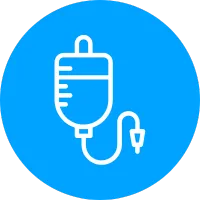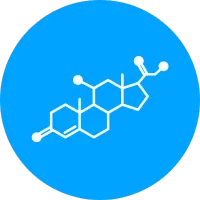Your Partners in Hope & Healing
The Genesis Center is an integrative health clinic dedicated to partnering with patients to prevent disease and discover the root causes of illness.
24+
Years in Practice
120,000+
Patients Served
6
Global Expert Partners
24+ Years in Practice
120,000+ Patients Served
6 Global Expert Partners
Holistic Wellness in Alpharetta, GA
When everything else has failed, we strive to help you uncover the root cause of your health challenges and find a better long-term solution.
Leading Experts for Chronic Health Challenges
Areas of Specialty
Cancer Supportive Therapy & Treatment
We specialize in Cancer Support Therapies and Treatments, offering patients personalized and comprehensive care to manage the side effects of cancer treatment and improve their overall well-being. In addition, we collaborate with state-of-the-art labs renowned for their expertise in cancer genetics and chemosensitivity tests, ensuring tailored treatment plans for the best possible outcomes.
Lyme Disease
Lyme disease is a bacterial infection spread to people through the bite of ticks. The infection is subtle, but the effects can be devastating - from joint pain and fatigue to serious neurological, cardiac and gut health issues. While most clinics aren’t looking for it, we specialize in curing it.
Mold Toxcicity
Mold toxicity from current or past exposure can lead to a range of health problems, from immunosuppression, neurotoxicity, to respiratory issues and hormone dysregulation. At The Genesis Center, we use personalized testing and treatment protocols to help you identify and address mold toxicity, so you can breathe easy and feel your best.
Heavy Metal Toxicity
Exposure to heavy metals such as lead and mercury, can lead to a range of health problems. Symptoms may range from fatigue & brain fog to neurological and behavioral changes. At The Genesis Center we offer personalized testing and treatment protocols to help you identify and address heavy metal toxicity, so you can achieve optimal health and wellness.
Pain Relief
We treat chronic pain conditions such as headaches/ migraines, joint pain, neurological pain and musculoskeletal conditions. Our personalized treatment approach includes nutraceuticals, PRP, PEMF Pulse Therapy, High Density Laser Therapy, Trigger Point Therapy and more.
Autoimmune & Neurological Disorders
Autoimmune & Neurological Disorders can be challenging due to their complex nature and diverse symptoms. At our practice, we take a comprehensive approach, combining advanced diagnostic tools with a dedicated team of specialists to identify and treat these conditions with customized solutions for each patient.
Anti-Aging Therapies
Our goal at The Genesis Center is to improve health and reduce the risk of age-related diseases. We offer a range of personalized treatments including hormone therapies, nootropics & IV therapies. These therapies help boost vitality, increase energy and improve cognitive function, so you can get the most out of life.
Hormone Therapies
Here at Genesis, we offer a wide range of bio-identical Hormone Therapies tailored to both women's and men's health needs. These include comprehensive support for menopause, testosterone replacement and hormone imbalances. Our approach aims to optimize hormone levels and enhance overall well-being.
Lyme Disease
Lyme is subtle but the affects can be devastating - from joint pain and fatigue to serious neurological and gut health issues. While most clinics aren’t looking for it, we specialize in curing it.
Mold
Mold exposure can lead to a range of health problems, from respiratory issues to fatigue and brain fog. At Genesis Medical Clinic, we use personalized testing and treatment protocols to help you identify and address mold exposure, so you can breathe easy and feel your best.
Bacteria
Whether you're dealing with a chronic bacterial infection or recovering from an acute illness, our personalized approach to healthcare can help you address the root causes of your illness and heal from the inside out.
Pain
Tired of living with chronic pain from headaches, joint pain, or other conditions? Our personalized approach to healthcare includes time-tested natural medicines and cutting-edge therapies to help you heal from the inside out and manage your pain more effectively.
Viruses
Tired of living with chronic pain from headaches, joint pain, or other conditions? Our personalized approach to healthcare includes time-tested natural medicines and cutting-edge therapies to help you heal from the inside out and manage your pain more effectively.
Heavy Metals
Exposure to heavy metals like lead and mercury can lead to a range of health problems, from fatigue and brain fog to chronic illness. At Genesis Medical Clinic, we offer personalized testing and treatment protocols to help you identify and address heavy metal toxicity, so you can achieve optimal health and wellness.
An integrative approach to healthcare
Our Services
PEMF Pulse Therapy
A non-invasive therapy known as pulsed electromagnetic field therapy (PEMF) utilizes electromagnetic fields to stimulate healing processes and alleviate pain. This innovative approach is effective in managing a wide range of conditions, like arthritis, fibromyalgia, depression, and various musculoskeletal disorders, offering patients a holistic and non-pharmacological option for improving their overall well-being.
IV Therapy
A targeted approach to delivering nutrients and medication directly into the bloodstream, for faster and more effective healing, particularly for conditions such as chronic fatigue, immune dysfunction, and nutrient deficiencies. IV Therapies we offer include: various Nutritional IVs, Myers Cocktails for cold and flu, High Dose Vitamin C, Glutathione, NAD, Ketamine, Chelation, Anti-fungal, and more
Thermography
Thermography is a non-invasive medical imaging technique using infrared cameras to capture thermal patterns emitted by the body. Our MDs use it to detect breast cancer, assess blood flow, and identify areas of inflammation to help tailor your treatments. We also prefer this technique because studies have shown it to be a safer alternative to mammograms and other imaging techniques.
Hormone & Endocrine Therapy
Hormone and endocrine support therapies offer a personalized approach to restoring hormonal balance and optimizing endocrine function through targeted dietary and lifestyle changes, supplements, and medications. Designed to support conditions such as menopause, adrenal fatigue, and thyroid disorders, these therapies help improve overall health and well-being by addressing individual hormone needs.
Pediatric Care
We provide family-centered primary care and functional medicine for children of all ages - combining well visits, sick care, and holistic approaches to support healthy growth, address concerns, and help every child thrive. From checkups and allergies, to ADHD, digestive issues, and sleep struggles.
Lyme Treatment
We provide advanced care for Lyme disease with Supportive Oligonucleotide Therapy (SOT), a custom treatment that targets bacterial DNA to stop replication. After precise lab testing, patients receive a single infusion that works continuously for up to six months. We also address co-infections, mold, Candida, and viruses to create a comprehensive path to recovery.
High Density Laser Therapy
Our High-Density Laser Therapy is a versatile treatment option, effectively addressing pain, swelling, inflammation, skin and nail infections, as well as sinus issues. This non-invasive approach utilizes advanced laser technology to provide relief and promote healing across various conditions, improving patients' overall well-being.
This is a Paragraph Font
High Density Laser Therapy
Our High-Density Laser Therapy is a versatile treatment option, effectively addressing pain, swelling, inflammation, skin and nail infections, as well as sinus issues. This non-invasive approach utilizes advanced laser technology to provide relief and promote healing across various conditions, improving patients' overall well-being.
Hyperbaric Oxygen Therapy
HBOT is a non-invasive treatment that uses the healing power of oxygen delivered under increased pressure to enhance circulation and support the recovery process. It has shown remarkable effectiveness in addressing many challenging conditions, including traumatic brain injury, stroke, chronic wounds, and various neurological disorders.

PRP Non-Surgical Joint Repair
Functional Medicine utilizes a holistic and evidence informed approach to identify and address the underlying causes of disease and imbalance across all systems of your body.

Regenerative Aesthetics
Antiaging therapies, such as hair restoration and microneedling, are aimed at recapturing youthful structure and function using your body's own systems.
Tailored To Your Unique NEEDS
Customized Treatment Plans
Women's Health
Using a compassionate and integrative approach, we create a personalized treatment plan to care for all your needs from fertility and family planning to hormone therapy to relieving monthly cycle discomfort, and more.
Men's Health
We provide personalized, holistic men's health services, including men's health screenings, sexual health concerns, and management of chronic conditions, all tailored to meet your specific health concerns.
Children's Health
We know your children are your highest priority and it's our greatest privilege to care for them! From routine illnesses to chronic conditions to preventative care that help them build a strong immune system, we're here to help them become all they can be!
The Challenges of Modern Medicine
Have You Experienced Any of These?
Treatment that manages the symptoms rather than addressing the underlying causes?
Limited focus on preventative measures and overall wellness?
A lack of personalized care and treatment plans?
An over-reliance on antibiotics and surgical procedures?
Not feeling heard by your previous healthcare providers?
Seen multiple specialists and still lack the answers you're looking for?
Our 4-Step Process
We Take a Different Approach
1
Initial
Consultation
We'll discuss your health concerns, goals, history and relevant lab info as well as order necessary labs.for review the following visit.
2
Comprehensive
Assessment
We'll examine your physical and mental well-being in-depth in correlation with your lab results..
3
Personalized
Treatment Plan
We'll develop a personalized plan tailored to your unique challenges and goals.
4
On-Going Support & Follow-up
We'll partner with you as you make progress towards your health goals.
The Challenges of Modern Medicine
Find Hope and Healing
Improved Physical Health
We help our patients identify underlying causes of health issues and use a combination of treatments to address them. This could include lifestyle changes, natural remedies, and complementary therapies, among others.


Improved Brain Health
We understand the connection between gut health and brain health and help our patients improve their mental well-being, clearing up brain fog and neuro inflammation through various treatments and therapies.
Increased Energy Levels
By addressing the root causes of fatigue, we have helped our patients improve their energy levels and vitality through a variety of methods including dietary changes, supplements, and treatments to support the body's natural processes.


Enhanced Overall Wellness
By adopting a holistic approach to health, our patients have achieved a greater sense of balance and well-being. This may include reducing stress, improving sleep patterns, and developing healthy habits, among others. We help our patients identify areas of their lives that need attention and develop a personalized plan to achieve optimal wellness.

Improved Physical Health
We help our patients identify underlying causes of health issues and use a combination of treatments to address them. This could include lifestyle changes, natural remedies, and complementary therapies, among others.

Better Mental Health
We understand the connection between physical and mental health and help our patients improve their mental well-being through various treatments and therapies. This may include counseling, stress management techniques, and meditation practices, among others.

Increased Energy Levels
By addressing the root causes of fatigue, we have helped our patients improve their energy levels and vitality through a variety of methods including dietary changes, supplements, and treatments to support the body's natural processes.

Enhanced Overall Wellness
By adopting a holistic approach to health, our patients have achieved a greater sense of balance and well-being. This may include reducing stress, improving sleep patterns, and developing healthy habits, among others. We help our patients identify areas of their lives that need attention and develop a personalized plan to achieve optimal wellness.
GENESIS CENTER
Patient Testimonials

Ashlynn P.
Dr. Sloan is hands down the best doctor i’ve ever seen and the front office staff is amazing as well! Very responsive and easy to get in touch with. I will forever recommend this office to anyone!

Tami M.
I should have written this years ago... The Genesis Clinic is "Heaven on Earth". Doc, his people, they are like family to me, and I thank them endlessly because I'm alive to write this Post. Their cutting edge approach to medical issues is vast and unending! Truly a Gift from God! Thank you for my Life Genesis Center.
Website by Automation Geeks








